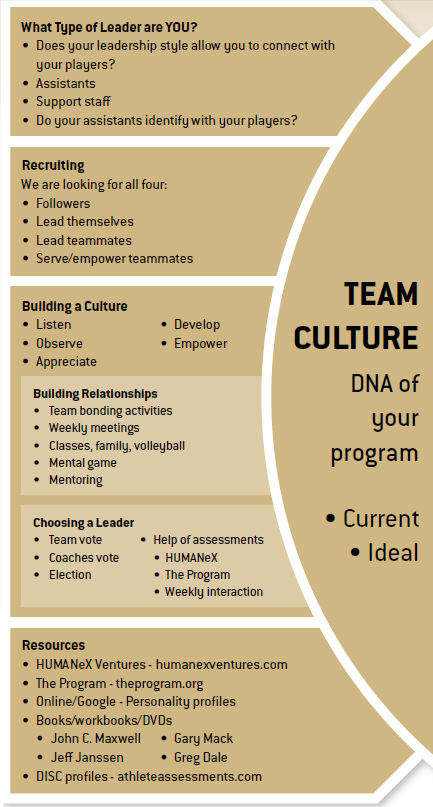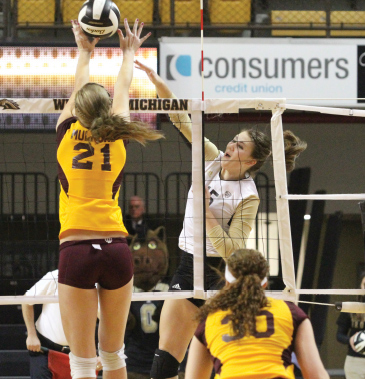|
Identify and Develop: Cultivating Leadership By: Colleen Munson, Western Michigan University Provided by: AVCA
We spent a lot of time in the off-season working on team-building activities that opened our eyes to the unique attributes each of our players and staff members brought to our program. Once a week we would gather as a team and play board games, introduced personality profile questionnaires, worked through riddles in groups with "like minded" teammates, created craft projects together and we even watched a Disney movie with popcorn at 8am! We learned to appreciate what we all brought to the program and began to value our differences. Little did we know we were equipping ourselves for the adversity we were going to face early in our fall season. In the first 10 days of the preseason (which, typically, should be an exciting time) we were dealt blow after blow from personal perspectives. Two of our players were dealing with deaths in their immediate and extended family that took them away physically and mentally from our program. On top of these circumstances, our senior leader was medically disqualified for the season after participating in our three-week preseason training and starting for us in our first preseason tournament. Without sharing too much, we found ourselves as players and as a staff in uncharted water, dealing with issues we had never navigated before as a program. Our fall season didn't start the way we anticipated and the adversity we faced didn't let up all season long, but our team pulled together and we eventually saw the results of our work off the court pay off as resilient players leading their teammates with a better understanding of holding each other accountable. Though it didn't come easy, we wouldn't trade the experiences and what we learned about each other along the way. As a staff we are so proud of the young women in our program and their reward for a job well done by earning a NCAA Tournament bid after winning our confer-ence tournament.
Leadership encompasses how you ad-dress, deal with and grow from adversity. We must be willing to meet our student-athletes where they are and equip them with the tools necessary to help them suc-ceed. We need to spend time with our players, really get to know the women we are coaching so we have a better understanding of those you can count on to lead your team on and off the court. As the head coach and leader of your program, this responsibility falls on you. Following our sub-par season, our staff realized we had some work to do. We asked ourselves, what is our current team culture versus our ideal team culture? We talked about our values and our vision for our program. It would be ideal to have a team that is cohesive and respects each other on the court. It doesn't matter if they're best friends away from the gym (though it'd be nice), but they need to be able to work respectfully towards accomplishing their goals. We value our team appreciating one another. If your team recognizes that they're working together for a common goal, they'll learn to listen to each other and accept everyone's differences. We had a vision of competitive, aggressive and confident players. We want to field a team of bold and courageous individuals, independent thinkers thinking beyond the information we share at practice. We envisioned a team of problem-solvers on the court; they have the answers and don't need to look to our staff on the sideline. We desire to have a team that plays with energy, is versatile, and we certainly hope they are coachable athletes. Develop a wish list for your own program and examine your leadership style along with your staff What type of leader are you? As a coach and leader, I like to think of myself as someone that listens to others and responds with feedback that empowers someone's best efforts. I give credit where credit is due and allow those I lead to make decisions on their own without nicro-managing every area of our program. I had to ask myself, do my actions match the image I have of myself? Did struggling on the court the previous season affect the way that I led the program? Does my leadership style allow me to connect with my players? Honestly, probably not all 15 of them — but I have to look at my coaching and support staff I have coaches and staff members that are able to fill in the gaps. Your assistants need to identify with the players as well, and you need to pay attention to where those connections are strong. If neither you nor an assistant connect with a player on your roster, that player will be miserable and it will weigh your roster down. With this approach in mind, we decided to divide our coaching duties and responsibilities much differently than we did in previous years. As the head coach, this was a challenge. I needed to let my staff take on their new roles, watch them grow, let them fail and learn from mistakes. I needed to step back and let my capable assistants go through the process. This is also true of the players we identify as leaders; we have to allow them to grow into their new roles as well. We realized that each of our student-athletes has a unique learning style. We found out over half of our team members are visual learners. For 10 years, we'd been bringing the players into the gym, telling them what to do and then getting started with drills, never realizing that we were missing out on connections with so many of our players. Now, knowing that we have so many visual learners, we bring a big white board into the gym, using diagrams and quotes to help get our message across at the beginning of practice and utilizing the board for new drills throughout practice. By using a white board and taking the time to have our players read what we are focusing on that day gives them something to think through, ask questions and assists in driving home the point which makes a lasting impression on our visual learners What motivates your players? Not just on the court, but what drives them in life? Do they have goals and aspirations? What do they want to achieve as a team? Do they want to win a conference championship or a national championship? Maybe some just want to feel like they are part of a team. Figuring out what motivates and drives your team members will give you the in-sight you need to push their buttons. Perhaps most important is to figure out how your student-athletes will respond to failure. Failure is woven into the fabric of sports. Wins and losses are part of the game and rarely do we see one of our players get through a match, let alone a practice, without making an error. Let's face it — they may well not have an error-free season. Do your athletes hang their head? Do they have poor body language? You'll be hard-pressed to learn this before practices start; it'll be something you need to observe over time. Leadership starts at the top. When you put in the work, strong leaders will emerge. I encourage you to take the time to develop your players into the mature leaders that they are capable of becoming on and off the court.
|



 Coming off one of our worst seasons our staff has had in 10 years, we were frustrated. We didn't understand why we struggled on the court during the season. Why didn't leaders emerge? We weren't holding one another accountable and it really showed in our body language and actions on the court. As a staff we needed to have a few hard conversations, which included roster changes as well as being honest with ourselves as we evaluated our leadership of the program. We spent hours discussing the experience that we wanted our players to have on and off the court and what we wanted the girls to take away from their four years in our program. After addressing conflict within our team and subsequently making some adjustments to our roster we noticed the culture of our program shift in the months that followed.
Coming off one of our worst seasons our staff has had in 10 years, we were frustrated. We didn't understand why we struggled on the court during the season. Why didn't leaders emerge? We weren't holding one another accountable and it really showed in our body language and actions on the court. As a staff we needed to have a few hard conversations, which included roster changes as well as being honest with ourselves as we evaluated our leadership of the program. We spent hours discussing the experience that we wanted our players to have on and off the court and what we wanted the girls to take away from their four years in our program. After addressing conflict within our team and subsequently making some adjustments to our roster we noticed the culture of our program shift in the months that followed.  Let me share our journey and the experiences we shared as a staff with our student-athletes that led to connecting with our student-athletes, building relationships and empowering leaders in our program.
Let me share our journey and the experiences we shared as a staff with our student-athletes that led to connecting with our student-athletes, building relationships and empowering leaders in our program.
 As we spent more time with our players we realized that the majority of our girls are inexperienced problem-solvers. Ask your players to describe the biggest prob-lem they have ever solved as it relates to a task, relationship or a challenge they faced. Who helped them solve it? What was the outcome? Looking back, would you approach the problem the same way? Seeing how they respond to these prompts will give you insight into how they process information, what experiences they have had and how they're likely going to handle adversity when it comes up within your program. The manner in which your student-athletes make decisions is also crucial to understand. If a player can't handle deciding where to eat lunch, do you want her setting in a tight match? Next ask them to describe the biggest decision they made in a particular week, month or year. This will be enlightening to you and your staff.
As we spent more time with our players we realized that the majority of our girls are inexperienced problem-solvers. Ask your players to describe the biggest prob-lem they have ever solved as it relates to a task, relationship or a challenge they faced. Who helped them solve it? What was the outcome? Looking back, would you approach the problem the same way? Seeing how they respond to these prompts will give you insight into how they process information, what experiences they have had and how they're likely going to handle adversity when it comes up within your program. The manner in which your student-athletes make decisions is also crucial to understand. If a player can't handle deciding where to eat lunch, do you want her setting in a tight match? Next ask them to describe the biggest decision they made in a particular week, month or year. This will be enlightening to you and your staff.



